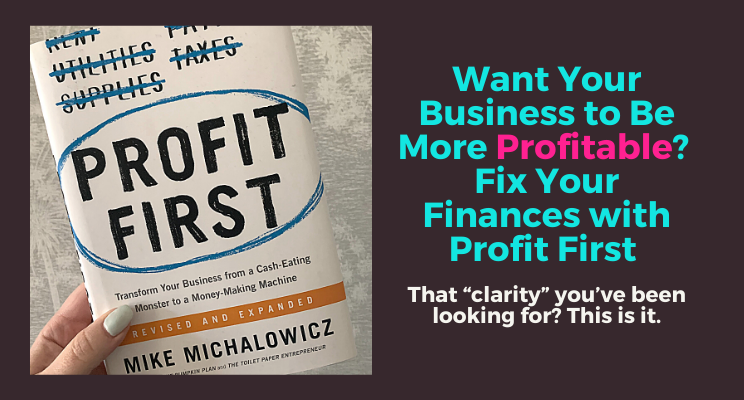That “clarity” you’ve been looking for? This is it.

Money. It’s one of the core outcomes of running a business, yet often the least understood by the entrepreneur. It’s a key factor in decision-making for a business, yet the entrepreneur rarely has clarity on where their finances stand.
Sometimes I wonder if I’m obsessed with money. I find myself talking about it multiple times a day and thinking about it hundreds of times a day. Yet, cultural norms have told me it’s taboo to talk about in my personal life with friends and family, and that I’m selfish or greedy if I desire more of it. Other, completely opposite norms, encourage me to keep up with the Joneses and strive for the next promotion or career advancement. We also make money mean things that it doesn’t, especially about our self-worth.
But still, I’m insatiably curious about my own and other people’s finances. Do they budget? Do they have debt? How do they decide what to spend their money on? How on earth do they afford to do and have all the things I see from the outside? Do they have support from their family? Did they get an inheritance? Do they have giant student loans they’re still paying off? Are they investing money or saving for retirement?
And as I’m writing these questions I’m noticing my own privilege and bias. I know that many people, especially marginalized communities, don’t have the luxury of even considering a lot of these things. A lot of things are seriously broken in our world, and our money system is one of them. But that’s a thought for another day.
My interest in finances has caused me to constantly question my personal systems. I hired a money coach, I use budgeting software, I even lived off cash envelopes for a few years (which worked amazing until the pandemic hit and no one would accept cash). I love reading about money (Gail Vaz-Oxlade is my favourite Canadian finance author) and I legitimately get excited when I have my weekly business money date. Yet, until I finally implemented Profit First, my business system was still wildly unhelpful.
Why do I love this system?
The reason I love tracking my finances is because it makes me feel clear and empowered. The number one thing most entrepreneurs want is “clarity”, yet they rarely look to their finances to provide it. The Profit First system is the most clarity I’ve ever felt in my business. It helps with decision making because you know what you can afford to invest in, and you know very clearly how much money you’re making. It relieves the mental burden that uncertainty causes. Using this system lifts the financial fog you’re likely feeling.
You also may find it draws back the curtain and reveals other issues. Once you resolve your money issues and you still find you’re struggling, you can’t blame your finances anymore. It’s a great time to look at what’s really going on.
What is the Profit First system?
Profit First is a book written by Mike Michalowicz (go and order it RIGHT NOW — no I’m not an affiliate, just a fan).
The Profit First system, for me, is a way of separating my money so I know what I have allocated for each thing in my business. That’s not what you’ll read as the benefit if you research the book, but that’s what it does for me. Every dollar that comes into your business gets reallocated to a different category based on a pre-determined percentage. You use different bank accounts for each category so there isn’t any arguing with the numbers, and the idea is that you don’t spend more than you have in each account, ever.
The accounts are:
Income (where every dollar passes through, but ultimately this account goes back to zero every time)
Profit (usually about 5% that just gets set aside, and you pay yourself a bonus from this account quarterly)
Owners Compensation (what you allocate to paying yourself on a regular basis)
Taxes (what you set aside for business taxes)
Operating Expenses (what you use to run your business, including any staff)
The conventional way of doing business is to collect money, pay your expenses, then maybe save for taxes, and maybe pay yourself something. You might just see what’s left, and maybe pay that to yourself. That system is what leaves most entrepreneurs broke, over-invested, and ultimately quitting to get a “real job”. With the Profit First system you reverse it and decide how much profit you want first, how much you’d like to pay yourself, saving the right amount for taxes, then running your business expenses from what is left. It’s a game-changer.
The real difference is when you need to make a decision, you’re not looking at a lump sum in your bank account and guessing how much you might have. Now if you want to pay yourself more, you can clearly see if it’s possible. If you want to hire someone, you know what your budget is. If you’d like to stop working with a particular client, you know what the financial impact will be. When it’s tax time, the money is already set aside. Ultimate clarity.
I won’t pretend to teach you everything about this system in one blog post. You absolutely need to read the book (hard-copy is better since there are lots of charts and diagrams). My goal today is just to convince you to do it!
What are the roadblocks when setting this up?
I won’t talk about the downsides, because frankly, there aren’t any. But there are a few things that trip my clients up when they try to implement this system:
1. They resist opening multiple bank accounts. It seems like a daunting task to organize with your bank, but usually it’s easier than they make it out to be. They key is to just set aside the time to make it happen. You can keep the account you’re currently using to collect money, so the only thing to do is create a few extra savings accounts you can link to it. The system recommends you use a different bank completely for some accounts, but I never did that just to keep it simple.
2. They find their expenses are too high. There is a transition period from doing things the old way to doing things this way. In the beginning, you need to use percentages that are realistic. This might mean that your profit account is only 1% or you pay yourself less than you want to. It also might mean drastically reducing your expenses so they’re within your means. This is a bummer to find out, but it’s amazing to find it out now rather than later. If this happens, then your old way of running your business was unsustainable and would have come to bite you in the butt eventually.
3. They aren’t in the habit of looking at their money. If you’re a head-in-the-sand entrepreneur, then just looking at your money at all will be an adjustment. I hope you can embrace it and even get excited about it since you will have so much more clarity and confidence when you do. I find this system to be extremely quick so it doesn’t take very long to manage.
Some Bonus Tips
One variation I made to the system was I added a “giving” account. This account takes a percentage of every dollar and allocates it to charity. I know if I leave that to come out of my pay or the expenses account I’ll never find money for it, so I take it right off the top. This allows my business to contribute meaningfully and consistently.
Another thing to keep in mind is ideally you wouldn’t spend down the pay account or the expenses account every month. You will find great relief in having a big buffer in those accounts especially if you have a low month in the future. I try to have a few months of extra pay saved up whenever possible so I don’t worry if there’s a lower month. If you find you can’t do that, then you’re likely paying yourself too much. If you keep a buffer in your expenses account that will allow you to pay annually for services which will save you money, or to invest in bigger things when the time is right. If you’re always spending every dollar, you have no wiggle room for anything else to come up.
If this entire system feels overwhelming to you, send your accountant or bookkeeper the book and have them help you. It’s really not complicated, and it’s easy to get used to once it’s all set up. Know that this resource has been vetted by hundreds of thousands of businesses, and you’re in great hands. Getting clear on your money is a critical step in your business becoming more profitable, so what better place to start than Profit First.
I am not a financial expert, so please seek out your own professional advice if you don’t feel confident implementing this on your own. Don’t let that hold you back from doing it! However, if it’s internal resistance you’re feeling to getting started, let’s talk. You can book a pitch-free, gift session with me to talk it all out.



